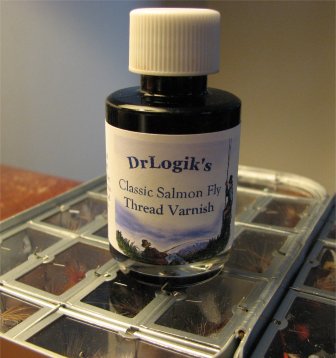DrLogik - Head Cement
"It's not about the fishing".
Site menu:
Head Cement - A Bit of Casual Research
Head Cement and its History
Introduction
January 27, 2006
I have had a curious interest in head cements ever since my first days of fly tying many years ago. Head cement selection can be a casual thing, a rigid protocol or a selection of habit it seems. The old masters did not have the selection we have today. Their options were limited basically to what was available at the local hardware store; in their case, varnish or lacquer.
My favorite tyer is Rueben Cross. His book "Tying American Trout Lures" was the book that I checked out from the library when I was just a youngster. I learned by myself with that book. He used Pratt & Lambert's "61" spar varnish.
During this casual research I have uncovered so many different head cements that, well, one could create a hobby of collecting them. Here are the ones I have uncovered so far; and the list continues to grow. If you know of a head cement that is not on this page, let me know and I will add it.
History of Finishes for Flies
It is not necessarily documented but is an accepted fact for most people that the tyers prior to the 20th Century did not use head cement, glues or finishes on their flies. Those tyers would include Frederick Halford from England and our own Theodore Gordon who spent many of his years fishing the Catskills and most notably the Neversink River. I will present an entirely different view based on this casual research. J.H. Keene in his 1881 book, "The Natural History, the Legendary Lore, the Capture of British Freshwater Fish, and Tackle and Tackle Making" provides recipes for many substances for fly making, wax, dubbing wax, dyes, etc and, "Varnish".
In Chapter IX he describes many of these recipes in great detail. He stated that, "Copal Varnish, with small quantity of Gold size and turpentine, takes some time to dry, but it makes a good whipping wax." He also provides recipes for Green Spirit Varnish, Colourless Spirit Varnish, Brown Varnish and Indiarubber Varnish. He did not call these "Head Cement" or "Head Varnish" but there is no doubt that he recommended a fly maker use these varnishes on the silk thread when making a fly. Copal varnish, being a natural resin and used as a "whipping wax" would provide the same results as our modern head cements back in his day; meaning, that it would help hold the silk thread together on the fly.
I have not yet found any conclusive evidence that Halford, Gordon, Cotton, etc. used head cement or varnish. However, it can be deduced that the concept of head cement and the products were available to fly makers at the latest by 1881 when Keene published his book; and quite probably long before that because he did not invent all of the recipes and concepts in that book. So the question then becomes, since varnishes, shellacs, etc were available back then, and considering the bamboo rod makers used them for their silk guide wraps, why then would it not be plausible that fly makers used varnish and/or shellac for the silk on their flies? In 1881 there is evidence that J.H. Keene did. I think now the argument should be, why wouldn't they have used these substances on the head of a fly? I present that the early fly makers did use an early form of head cement. Whether other fly makers chose to use it, or thought about using it was their own choice.
Between Theodore Gordon and the most recent Catskill masters (Dave Brandt, Poul Jorgensen, Mary Dette, Ralph Graves, Frank Kuttner and many others) lived Reuben Cross, Harry and Elsie Darbee and Walt and Winnie Dette. Reuben Cross can trace his roots back to Theodore Gordon and claimed that he learned directly from Gordon the techniques that evolved into the Catskill-style dry fly. Walt Dette learned from Reuben Cross and in the book about the Dette family ("The Dette's" by Leiser) Walt stated that he basically had to trick Cross in to teaching him the correct technique by intentionally doing it wrong and proclaiming it was a great fly! Cross would then, according to Walt, say, no, no, no, you do it this way...and proceed to show Walt the correct technique. I wish I could have been there to see that!
Spar Varnishes for Head Cement
In Cross's book, "Tying American Trout Lures", Cross's only reference to the type of head cement he used is on page four and states:
"Happily, they (refering to tools for fly tying) are few and inexpensive - a tying vise, hackle pliers, manicuring scissors, patent-spring clothespin, large darning needle, razor blade, piece of beeswax, tying silk and, last but not least, a small can of good waterproof varnish."
In Cross's case he used Pratt & Lambert "61" spar varnish as seen in a photograph of his book on the following page (and further below on this web page). Considering that the 1st edition of "Tying American Trout Lures" was published in 1936 this may be one of the first American tyers to document its use. Ray Bergman's book, "Trout" was first published in 1938 but does not seem to mention the use of head cement; although three pages with illustrations were devoted to waxing silk thread!
Harry and Elsie Darbee also reportedly used spar varnish; as did the Dette family (Walt, Winnie and their daughter Mary). Mary still uses spar varnish to this day and applies it to the head of a fly with an antique glass syringe. She calls it her "Varnish Needle" and is passing that tradition down to her grandson as he also uses spar varnish and applies it with a syringe as well.

Although I have scored a couple of pristine BD Yale 10cc syringes on eBay, I have not yet been able to effectively apply the varnish with a syringe. Getting the pressure on the plunger right may be key. Suffice to say the next time I am in Roscoe, NY I'll be stopping by the Dette shop to ask Mary how she does it.
If you have the time to let it dry, spar varnish makes a great head cement.
Lacquer-based Head Cements
Many other modern Catskill masters also use spar varnish as well as lacquers in their various forms. I imagine they use lacquers since they dry much more quickly on the fly. In the years I have known one notable Catskill and highly skilled tyer, I have seen him use primarily lacquer-based head cements. Most recently this tyer was using Serge Boulard's Pro Lak cement; which appears to be, at least by sniff test, to be a lacquer although it is gin-clear and not a pale yellow color.
The well known Western fly tyer A.K. Best, in his book, "Production Fly Tying", advocates the use of common hardware store lacquer for its economy and fast drying qualities.
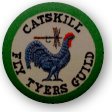
I often use Nitrocellulose Lacquer that I purchased from a woodworking store. I tried the "brushing lacquer" but found it a bit too thick. I then tried the "spray lacquer" and found it too thin...runs all over the place if you are not careful. I was building the fly tying desk displayed elsewhere on my site and was looking for a nice lacquer for it. I stumbled upon Valspar's Luster Lac 90. I used it to finish the fly tying desk and tried it on some flies. Many of the "lacquer" head cements you purchase appear to be a very small bottle of nitrocellulose lacquer that you can get at the hardware store for a whole lot less money...(like A.K. Best says). If the head cement is a pale yellow color (or clear) and smells like lacquer thinner, it is a good bet it is lacquer.
Flexible Head Cements
Many tyers also like the "soft" and flexible properties of another form of head cements that I call "Flexible Cements". Softex, Flexament are two of the more common ones found in stores. These cements reportedly offer a more flexible and resilient head finish that is more durable than "harder" finishes such as lacquers and varnishes (although I cannot call true spar varnish a "hard" finish since it can take months to totally cure). Whether or not flexible cements are actually more durable than hard finishes is probably another hotly debated topic.
UV-Cured Glues and Cements
They aren't new on the scene but UV glues and cements have come a long way in the last couple of years. Once upon a time ago even the "hard" finish products had a sticky texture once cured. No more. Products like SilverCreek's Crystal UV Coat and FlexThin Coat and the Solarez products are wonderful! The main difference these days is how long it takes the product to cure. They now cure in seconds! I don't use these products for head cement but for Buzzer bodies and quill-bodied flies they work great!
Home-made Head Cements
Many fine head cements can be made at home with a little research and experimentation. Thin ShooGoo with toulol/toluene to get a home-made version of the commercially available flexible cements. I have tried this and you do get a nice thin flexible cement for a lot less than you spend for the commercial bottle but the initial outlay does cost more. If you like this kind of cement, it might be worth trying it out as you can also control the viscosity.
 An old head
cement mentioned in the May 1941 issue of "American Fly Tyer"
magazine calls for Ambroid cement diluted with toluene to get a thinner
solution. Ambroid cement has been around for a very long time but it is
becoming increasingly harder to find. A good hobby store should have it.
I have used this little recipe but it does not give a particularly glossy
head and it smells up the house pretty good. However, since it is quite
literally a cement it does a fine job at holding things together. Although
I have not used it as such, it would probably make a good cement to hold
feathers together (such as Jungle Cock, etc) without giving them an un-natural
shine or sheen and it would also maintain their flexibility since it is
designed be to a flexible cement. Frankly speaking, this little concoction
replicates the "properties" of Pharmacist Formula head cement
very closely (soaks in well, doesn't dry too fast in the bottle, etc) although
it doesn't have the same glossy effect.
An old head
cement mentioned in the May 1941 issue of "American Fly Tyer"
magazine calls for Ambroid cement diluted with toluene to get a thinner
solution. Ambroid cement has been around for a very long time but it is
becoming increasingly harder to find. A good hobby store should have it.
I have used this little recipe but it does not give a particularly glossy
head and it smells up the house pretty good. However, since it is quite
literally a cement it does a fine job at holding things together. Although
I have not used it as such, it would probably make a good cement to hold
feathers together (such as Jungle Cock, etc) without giving them an un-natural
shine or sheen and it would also maintain their flexibility since it is
designed be to a flexible cement. Frankly speaking, this little concoction
replicates the "properties" of Pharmacist Formula head cement
very closely (soaks in well, doesn't dry too fast in the bottle, etc) although
it doesn't have the same glossy effect.
Advantages of Head Cement
One reason I believe that head cements became popular is durability of the fly. Back in the 1930's when Reuben Cross was in his heyday, flies were probably considered an expensive luxury. One did not want to pay top dollar for a hand-tied fly only to watch it unravel after a couple fish. I have not yet been able to determine who is "reportedly" the first tyer to use head cement. I wouldn't be surprised if it was Reuben Cross since he was a very serious and steadfast tyer who was constantly looking for ways to improve his flies.
It is generally accepted that a well tied fly with head cement will last longer than one without head cement. ...although that point is also hotly debated amongst modern fly tyers.
Disadvantages of Head Cement (Have to be fair here)
Generally speaking I think the advantages of using head cement out-weigh the disadvantages but here are some disadvantages I and others have observed:
- Head cement gives off an odor that the fish can smell - Yes it probably does if the fly is used soon after ANY head cement is applied. After the volitiles have evaporated, I am not so sure they pick up on any discernable odor but I also have no scientific data to back that up. Besides, fishermen have been catching a lot of fish over the decades on flies with head cement!
- Head cement adds more weight to a delicate dry fly and can alter the fly's balance or floatability. It can also prevent water from penetrating a nymph and therefore prevents the nymph from sinking as quickly as it should. Perhaps, but I think that is stretching it a bit. I have heard fisherman say these things though.
- It is one more step in tying a fly that takes time and slows down the process. ...True; however, tying on a new fly after a couple of fish unravel one takes time to.
- Head cement glues-over the hook eye and makes tying on a tippet difficult. Yes it does if it is not taken care of at the vise!
- If head cement is applied haphazardly, it can create a sharp edge in the eye and facilitate a "long release" of a fish when the tippet abrades and snaps. True if using a "hard" finish-type head cement such as lacquer-based head cements and the cement is applied sloppily and the hook eye is not cleaned at the vise. However, if flexible cements are used, I really do not see this as much of a problem.
Other Head Cement Research on the Web
Al Campbell had a good one-pager article on the various head cements. He mixes a few of his own and offers some of his recipes. [Link is now gone]
Wayward Article - "The Sticky Myth of Head Cement" - The author explores the use of head cement...rather, why we shouldn't use it. Interesting point of view and it has merit. [Link is now gone]
Available Head Cements - (Not a Comprehensive List)
This is a quick run-down of the head cements I have seen or heard of fly tyers using these days. They are in no particular order and this is not a head-to-head comparison.
Update as of August, 2025: Most of the mainstay solvent-based head cements we have been using for years are no longer on the market or available to us in the USA. They include: Pro-Lak, Superlak (both from Canada), Dan Bailey's head cement and Griff's. If you find a bottle of any of these I'd suggest you buy it for posterity's-sake.
Any of the other solvent-based head cements are also probably not long-lived considering the VOC laws that have been passed in the last few years - or the formulas have changed. That applies to lacquers, spar varnishes, etc. that we used to take for granted that we could get at the local hardware store. Luckily for us woodworking stores still sell Nitrocellulose Laquers that work really well for head cement as discussed above.
Veniard's Cellire Varnish and Floo Goo - Veniard is one of the oldest and most respected names in fly tying materials. Cellire varnish does not appear to be very popular in the US but it does hold a lot of counter-space in shops in Europe. It has a very loyal following. They also produce Floo Gloo and it appears to be a flexible-style cement.

Lagartun Lacquer - Lagartun comes to us from France. It is a lacquer-based product that comes in a number of translucent colors as well as a glow-in-the-dark and shimmer version.
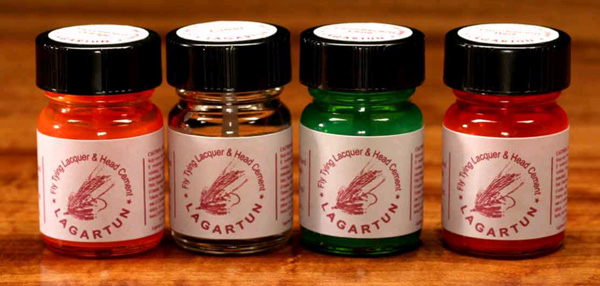
Lagartun's Glow-in-the-Dark version. This lacquer is very cool! It can also be used on other items to make them more easy to locate in the dark. Don't let your kids know about this stuff or they'll paint everything in site!
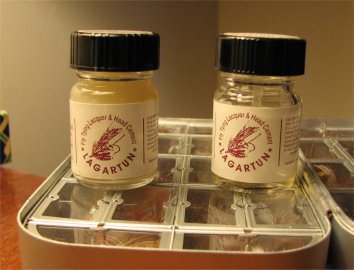
Lagartun's shimmer head cement:
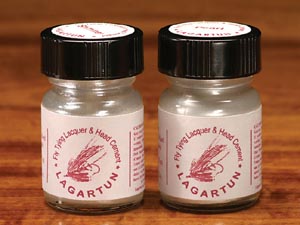
Dan Bailey's Head Cement - The venerable Dan Dailey has his own head cement that he uses on all of the flies that he sell's from his shop. A sniff test indicates it's a lacquer. The bottle's label says it is made by Midwest Lacquer, Chicago, IL. A bit of further research found that Midwest Lacquer got bought by another company recently. That company makes industrial coatings for containers. They evidently consolidated their manufacturing plants. This cement provides a nice glossy head.
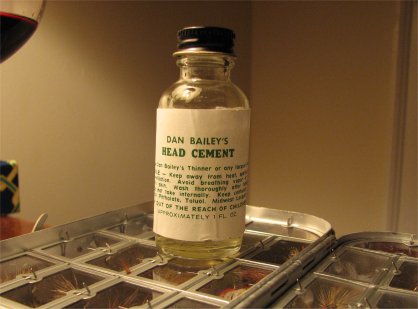
Dave's Flexament - Flexament has been around for a long time and has a loyal following of tyers. It offers a more flexible finish than lacquers or varnishes. Be sure to have a bottle of Dave's thinner on hand though.
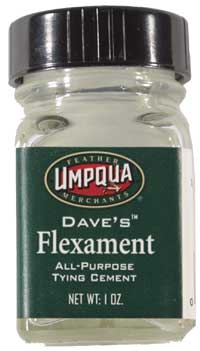
Exo-Flex Head cement - I do not know too much about this product other than it is a flexible product and readily available in many fly shops.

Fly-Rite's Fly-Tite Head cement - This is a product that Fly-Rite brings to the table. If you watch the Oliver Edwards "Essential Skills" DVD's, this is the head cement he reaches for quite often. The cement goes on the fly very nicely and forms a slightly rubbery flexible finish although not very glossy. It provides a semi-gloss finish. The "Dilly Wax" he refers to for fly floatant is also by Fly-Rite.
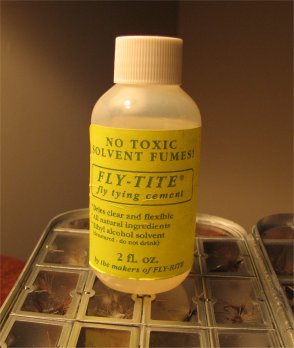
Griffin Head cement - Griffin makes two versions, thick and thin. This is a very common product found in the US. A lot of my friends use this stuff because it is so readily available in our area.

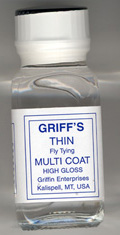
Rumpf Head Cement - "The last name in fly fishing" Made by Raymond Rumpf & Son since 1968. A quick sniff test indicates it is a lacquer-based head cement.
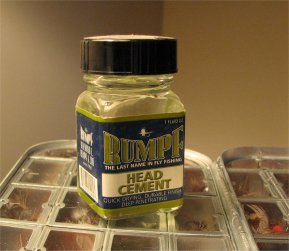
Backcountry Laboratories Hard as Hull - Funny name but this product also seems to be a very popular head cement. This is the stuff that Lefty Kref includes in his "Eventuality Kit".
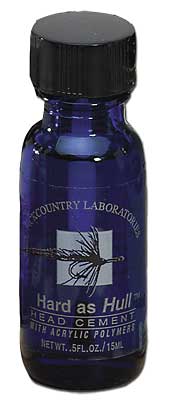
Loon Outdoors Head cement - Loon makes a few eco-friendly products. Hard Head is one of them:

Loon's water-based head cement:

Loon's Soft Head product:
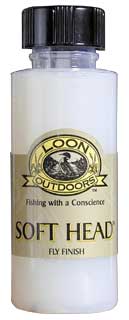
LureFlash - This product does not appear to be readily available in the US although it seems to be popular in Europe. This is their Glass Build product. Glasgow Angling in Scotland carries it.
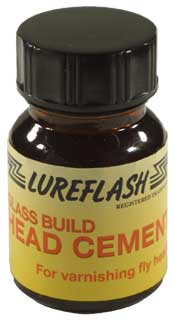
LureFlash Feather Weld formula is used for coating feathers to increase their durability:
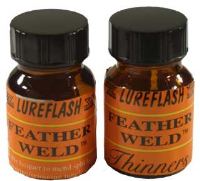
Harry Murray's Head cement - The famous Virginia guide Harry Murray has a fly Shop and produces his own head cement (VERY thin stuff indeed!) and Wing Kote. The Wing Kote is interesting stuff. I was in Harry's shop the summer of 2010 and talked to him and bought some. He wouldn't divulge the ingredients (no surprise there) but I did find that it did its intended job well but needed constant shaking to keep the stuff in solution. A sniff test indicates it's a lacquer-based product.
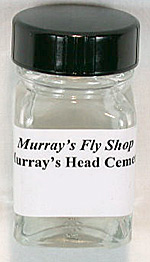

Wapsi Head cement - Wapsi produces their own head cement as well and it comes in a handy applicator bottle:
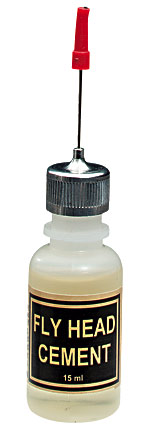
Black Duck - This company re-produced their own version of Pharmacist's Formula but unfortunately went out of business not too long ago. It took a bit of digging but I did score two new bottles from remaining inventory at a western fly shop recently. A quick smell test tells me that it contains some of the same chemicals the original Pharmacist Formula contained; however, the color is much lighter and it is much more viscous than Pharmacist Formula. It does not evaporate much out of the bottle...one claim that Pharmacist Formula had.
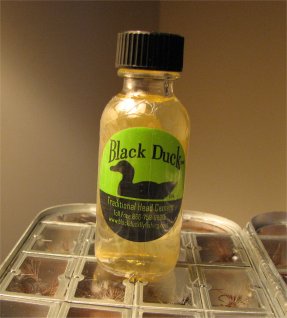
Serge Boulard Head cement - Serge Boulard is a Canadian company that wholesales to the fly tying shops. The cement comes in different colors. A Catskill fly-tying friend of mine showed me this cement at a recent fly show and he likes it quite a bit. It's difficult to source here in the USA. It is a very fine quality head cement and is easy to work with. Evidently this head cement is very popular in the Salmon Fly tying community as well...especially the black color. I can see why. This cement goes on very smooth and evenly...very easy to control and makes a nice glossy head. This cement has become my go-to head cement. These guys have it and they will ship to the US.
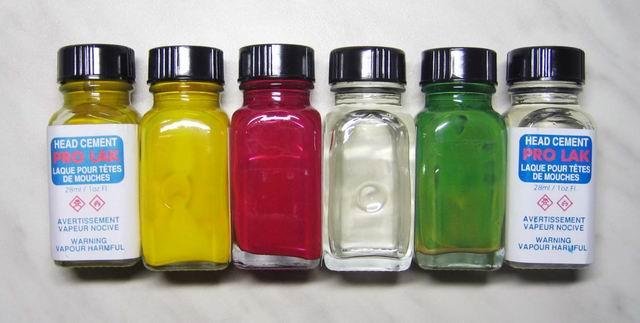
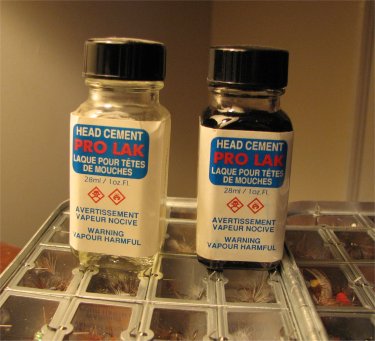
Pratt & Lambert "61" varnish - My fly tying hero Rueben Cross used this varnish as did famous bamboo rod maker Everett Garrison on his rods (see the can near the center of the photograph of Cross's tying desk). This varnish is still available but is not the same formula that was sold back when Rube was using it. Pratt & Lambert does make a great outdoor varnish called Vitralite though. It is a very tough spar varnish with UV inhibitors. I have used it as head cement and it does work nicely as long as you are using a dark thread as it is a very dark amber/brown color.
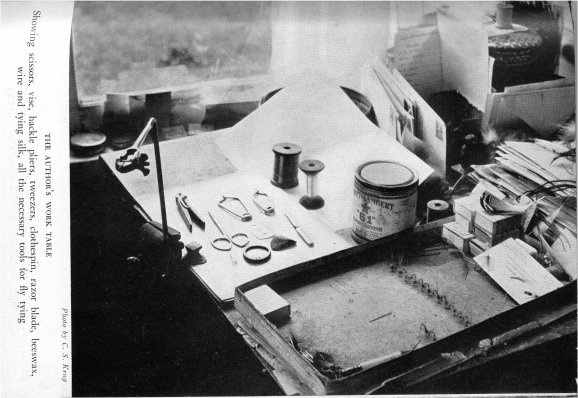
Pharmacist Formula Head cement - This product has not been available for many years. Some tyers say it could be one of the best head cements ever made. I found it to be an excellent head cement with properties few others have. It penetrated the threads entirely, didn't dry in the bottle, dried fast on the fly and made a nice hard glossy finish. Suffice to say that it has a loyal following. I just acquired this bottle of Pharmacist Formula. A quick smell test indicates, that, well, it has a funky chemical Bourbon-like smell. That's right, it smells like whisky...looks like it to. As a matter of fact, I suspected that the person who owned the fly tying kit that this came from may have poured out the real cement and poured his dad's Jack Daniels in its place. I tested it to be sure and also asked another owner of Pharmacist to validate that the color is right. It checked out. This is the real deal.
The ingredients indicate that it contains hydrocarbons ( a generic term that could indicate just about anything - mostly flammable things) alcohol, ketones and esters. No wonder they called it Pharmacist Formula. There's no telling what is actually in this head cement but it does provide a nice glossy head finish and soaks in better than any other head cement I have used. Notice also the warning label, "...do not induce vomiting, call a physician. If patient is unconscious, give him air". Nice!! I think I will reserve this stuff for special flies until I can get another bottle.
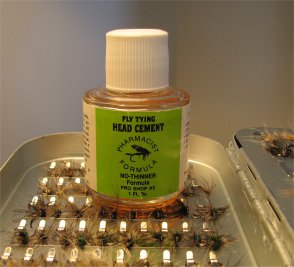

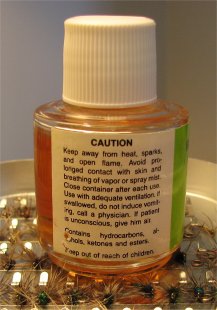

Sally Hansen's Hard as Nails polish - This is a very popular head cement, er polish, among the Catskill dry fly crowd. Many notable tyers use it, Dick Talleur being one of them. Oh, and it comes in cool colors to...imagine that! Funny how they market one bottle in a very lady-like feminine manner and right next to that display are these bottles that have a more masculine appeal...read "Hard...Nails". Somebody at Sally Hansen did their research to broaden their market it would appear. Smart, very smart!
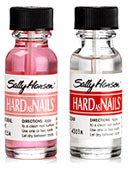
Softex - A flexible head cement that is popular amongst the salt water fly tying crowd
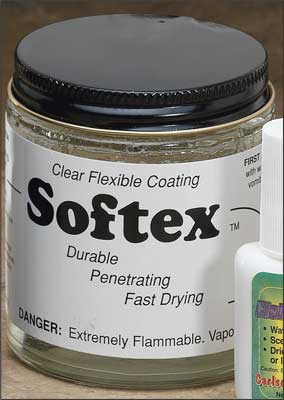
Zap-A-Gap - A cyanoacrylate-type head cement/glue that is popular

Fishin' Glue - Another head cement
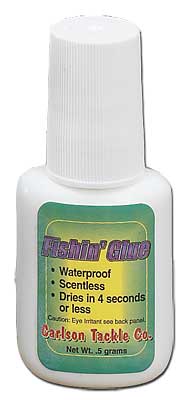
Angler's Corner Fly Tying Water-based Head Cement - Angler's Corner product - I have not seen this head cement on the East coast. I ordered a bottle and tried it out. It is a good cement but tends to separate in the bottle and has to be shaken often.
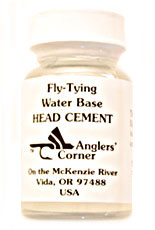
Hard Headed - By Angling Evolutions - A non-toxic head cement:
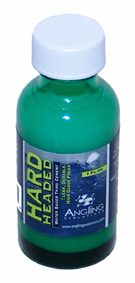
Giorgio Benecchi's Head Cement - Giorgio Benecchi - Sniff test suggests it is nitrocellulose lacquer. I just got this in from Henrik at www.flyco.dk. The bottle is on the small size but it does come with a pin attached to the inside of the cap. The pin is actually quite thin and precise (read: it really works!). The lacquer dries a satin sheen not glossy. This is nice product indeed!
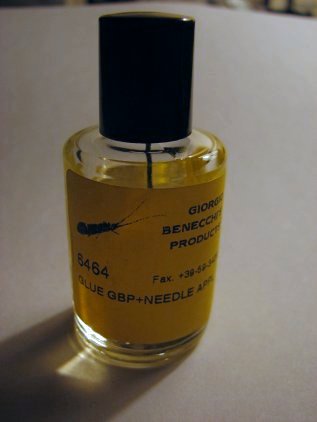
Fritz von Schlegell - Head Cement - Very thin head cement. Smell test indicates it's probably a lacquer-based head cement but I can't be sure. This cement really soaks into threads well. It has a very unique and patented built-in retractable brush/applicator. As I recall, the late Poul Jorgensen recommended this head cement in one of his books.
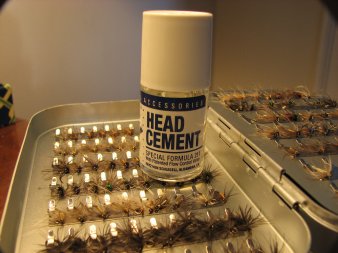
SuperFly Superlaq - Available from www.superfly.ca appears to be a laqcuer-based product by quick sniff test. This product penetrates well and gives a nice glossy head. Like Pro Lak this product comes from Canada and is difficult to source here in the USA. I ordered this bottle from a fly shop in Canada.
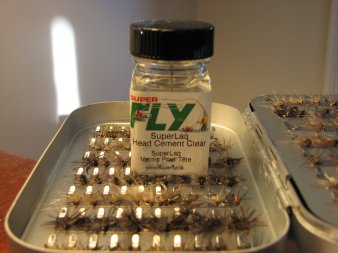
Trout Hunter Head Cement - From famous Western guide and fly tyer Rene Harrop comes his water-based head cement. A very nice glossy head cement for those folks who have young tyers in the home or experienced tyers who don't want that chemical smell in the house.
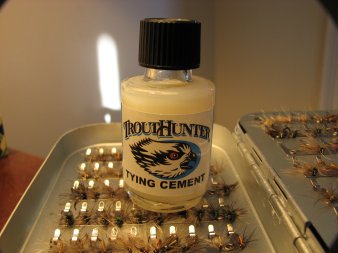
DrLogik's "Nitro-Formula" Head Cement - DrLogik - Uh oh! What's this? DrLogik's own head cement?? Yep, something I have been working on in the background. This is the first attempt at making a better head cement. This is a genuine nitro-cellulose lacquer.
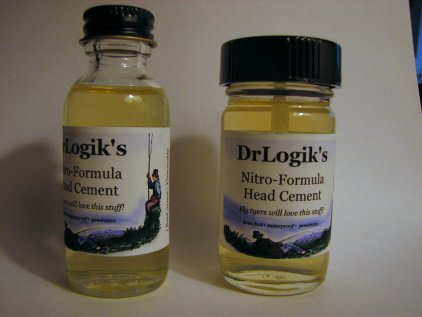
DrLogik's own Traditional Amber Thread Varnish
Traditional Amber Thread Varnish - Here is an old thread varnish formula I put together. This varnish takes about a day to dry but provides a translucent, very durable and very glossy and waterproof head. It is virtually impervious to water. It penetrates silk thread and turns it a beautiful translucent color of the thread used. Made from walnut oil, spar varnish, alkyds, heat and a lot of love. A similar formula is used by bamboo rod makers for their guide wraps. Flies are in the water though and I adjusted for that.

DrLogik's Classic 19th Century Salmon Fly Varnish - Here is another formula I created . It is based on a 19th century Kelson formula that contains "Asphaltum", spirits, heat and care. The first batch came out a little too viscous. This is from the second batch and it seems to be just the right consistency. It has an obsidian-like black finish and dries fairly quickly. Considering the raw materials and how they are formulated, it should provide a waterproof and permanent glossy black finish on the finest salmon or Steelhead fly. This is some interesting varnish! Kelson did his homework on this.
